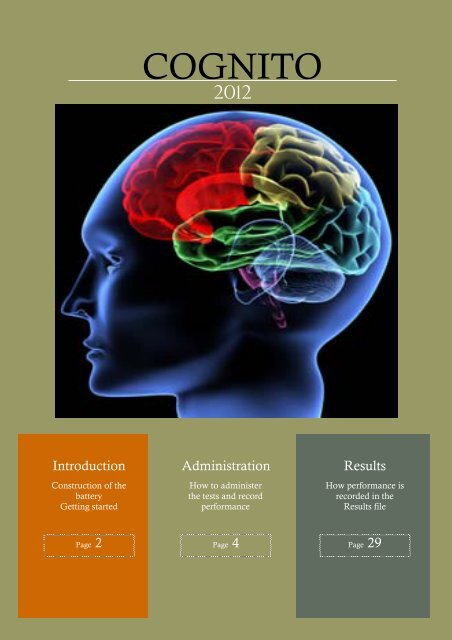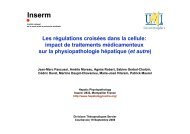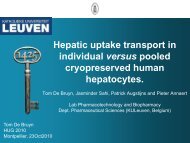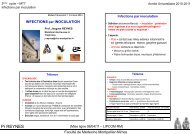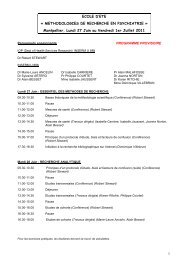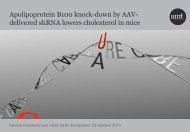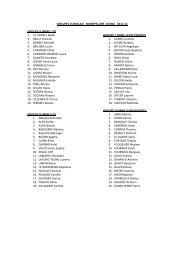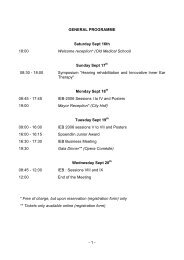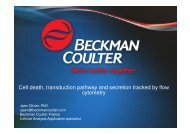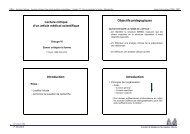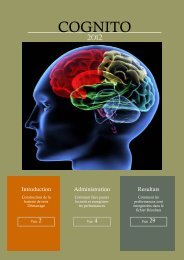COGNITO - Inserm
COGNITO - Inserm
COGNITO - Inserm
You also want an ePaper? Increase the reach of your titles
YUMPU automatically turns print PDFs into web optimized ePapers that Google loves.
<strong>COGNITO</strong><br />
2012<br />
Introduction<br />
Construction of the<br />
battery<br />
Getting started<br />
Administration<br />
How to administer<br />
the tests and record<br />
performance<br />
Results<br />
How performance is<br />
recorded in the<br />
Results file<br />
Page 2<br />
Page 4<br />
Page 29
Introduction<br />
<strong>COGNITO</strong> is a computerized neuropsychometric examination<br />
based on well-known cognitive tests designed for both<br />
cognition research and clinical assessment. It was originally<br />
developed with MacIntosh Hypercard software (version ECO)<br />
for use in both population and clinical studies of brain ageing<br />
and has now been up-dated into Flash, thus extending its<br />
hardware possibilities. The original version was used in a<br />
prospective population study from general practice from which<br />
normative data was derived, and the ability of the battery to<br />
detect difficulties in information processing two years prior to<br />
the diagnosis of dementia was also established. The battery has<br />
been subsequently used to track cognitive changes due to<br />
depression, following anesthesia, as a consequence of<br />
anticholinergic drug use, and in the development of diagnostic<br />
criteria for mild cognitive impairment (MCI). More recently<br />
<strong>COGNITO</strong> has been used to monitor cognitive changes during<br />
treatment in schizophrenia. <strong>COGNITO</strong> assesses reaction time,<br />
primary and working memory (an articulation sub-test further<br />
permitting identification of problems related to the articulatory<br />
loop) visuospatial and verbal secondary memory (with free,<br />
cued and multiple choice paradigms) , implicit learning<br />
(priming), language skills (word and syntax comprehension,<br />
naming, verbal fluency), functional and semantic<br />
categorization of visual data (visual reasoning and form<br />
perception), focused and divided attention (visual and auditory<br />
modalities) and crystallized intelligence (vocabulary).<br />
Responses are made via a tactile screen which permits the<br />
recording of response latency (deducting reaction time provides<br />
an estimation of information processing time). The<br />
examination may be carried out by trained lay interviewers<br />
with the possibility of the interviewer’s voice being replaced by<br />
pre-recorded instructions. The interpretation of the results can<br />
only, however, be made by a clinician competent in<br />
neuropsychology. Qualitative aspects of performance<br />
(perseveration, intrusions, visual field neglect) are also<br />
recorded. The test is suitable for children over 12 and adults of<br />
any age provided they are able to read, hear instructions and<br />
see the words and images. Practice trials are given which may<br />
be repeated until the subject has understood what is required.<br />
In order to be able to test highly performing persons some of<br />
the tasks become very challenging, so some tests stop<br />
automatically after repeated failures to avoid discouragement.<br />
The examination takes 45 minutes to an hour to complete<br />
depending on the ability of the subject. While it is possible to<br />
select and administer specific tests, it is suggested that the<br />
whole battery be given where possible in order to standardize<br />
fatigue effects and the time delay between the presentation of<br />
memory stimuli and the recall trials.<br />
2
GETTING STARTED<br />
Home page<br />
Identification page<br />
Subject details and test selection<br />
1. HOME PAGE<br />
2. IDENTIFICATION<br />
3. SUBJECT DETAILS<br />
On this page select either<br />
the French or the English<br />
version of <strong>COGNITO</strong>.<br />
From this page you may<br />
start a new testing session,<br />
complete an examination<br />
which has already been<br />
started or exit from the<br />
battery.<br />
You must select one of<br />
these options by the mouse<br />
or touching the screen in<br />
order to proceed with the<br />
examination or end the<br />
session.<br />
In order to begin testing a<br />
file name must be entered.<br />
This will be the name given<br />
to the Results file which<br />
will appear automatically<br />
on the Desktop upon<br />
completion of the<br />
examination.<br />
You may then either cancel<br />
the session (in which case<br />
no file will be created) or<br />
touch Enter in order to<br />
continue.<br />
The date and time of the<br />
examination will be entered<br />
automatically but may be<br />
modified. Age, sex and a<br />
subject identifier must be<br />
given. The interviewer may<br />
add remarks here relating<br />
to test conditions.<br />
The Summary button will<br />
show the list of tests and<br />
those which have already<br />
been administered (in the<br />
case of redoing the battery).<br />
A filled in white dot next to<br />
the test name indicates a<br />
completed test, a half-filled<br />
dot an uncompleted test.<br />
See page 5 for further<br />
functions on this menu.The<br />
Start button commences<br />
testing.<br />
3
1. REACTION TIME The test measures simple reaction time using the dominant hand. When a<br />
stimulus (a clown) appears on the screen, the subject must press the space<br />
bar. The time recorded appears on the screen.<br />
After reading the instructions to<br />
the subject press the Start button<br />
to begin the 5 Practice trials.<br />
The subject should have his finger<br />
just above the space bar in<br />
preparation for each stimulus. The<br />
practice trial may be repeated as<br />
often as necessary if the subject<br />
has difficulty in understanding the<br />
instructions or begins to touch the<br />
bar before the stimulus has<br />
appeared.<br />
Trials are given with random inter-trial intervals.<br />
The reaction time is recorded to one hundredth of a second. A correct<br />
response will be between 100 and 500 milliseconds.<br />
If the subject responds before 100 milliseconds it is counted as an<br />
Anticipation error. If the subject responds between 500 and 2000<br />
milliseconds it is considered a time Lapse problem (an very slow response -<br />
subject has probably been distracted from a correct response leading to a<br />
possible outlier score). If the subject does not respond at all after 2 seconds it<br />
is considered a failure (Over Time error).<br />
The test is terminated when the subject has recorded 12 valid responses. A<br />
maximum of 36 trials may be given.<br />
The interviewer should only start<br />
the real test when the instructions<br />
are understood<br />
In the Results file the following are recorded:<br />
- Validity of response for each trial<br />
- The mean of the 12 valid responses<br />
- Total number of trials by the subject<br />
- The number of Anticipation errors<br />
- The number of time Lapses<br />
- The number of Over Time errors<br />
4
2. FAMILIARISATION TASK<br />
USE OF THE TESTING MENU<br />
Familiarisation<br />
This task is designed to familiarize the subject with the tactile screen. It is not scored or recorded<br />
in the results. The subject is asked to touch the stimulus (the clown from the reaction time test)<br />
and differentiate two stimuli (name of the clown). The subject then touches the clown at 3<br />
different places on the screen.<br />
The testing menu<br />
Taking the cursor or touching the upper part of the screen will make a menu bar appear in green.<br />
From this menu the interviewer may activate/disactivate a voice which reads the instructions for<br />
each test, see the list of tests which have been started and completed, go to the next test or back to<br />
the last test, return to the <strong>COGNITO</strong> home page or exit from the battery. This menu accompanies<br />
every test in the battery.<br />
5
3. READING AND SYNTAX<br />
COMPREHENSION<br />
The test is in two parts. The first a<br />
simple reading task and the second<br />
a comprehension task in which the<br />
subject carries out instructions of<br />
increasing syntactical complexity.<br />
The subject is given one practice<br />
trial. If the subject is unable to read<br />
and understand the sentences then<br />
it is unlikely that the results for<br />
subsequent tests will be valid. Press<br />
the Start button to commence the<br />
test.<br />
The subject is required to read the<br />
sentence. This is scored by the<br />
interviewer as C=Correct or<br />
I=Incorrect. The scoring options<br />
are activated by passing the mouse<br />
or touching the upper right hand<br />
part of the screen. This must be<br />
done in order to move on to the<br />
next part of the test. If the subject<br />
does not respond within 10 seconds<br />
the next trial is given and a Time<br />
error noted.<br />
The subject must now carry out the<br />
instruction given in the sentence.<br />
This will be scored as Correct or<br />
Incorrect in the Results file along<br />
with the response latency (time<br />
taken to reply). The subject is given<br />
5 trials.<br />
The following appears in the<br />
Results file:<br />
- Number of sentences read<br />
- Number incorrectly read<br />
- Number correctly<br />
understood<br />
- Incorrect response<br />
corrected<br />
- Number of Time errors
4. AUDITORY ATTENTION<br />
The subject is asked to<br />
discriminate between long and<br />
short sounds presented at<br />
variable intervals and to count<br />
only long sounds. The<br />
interviewer should use the<br />
practice trial to determine<br />
whether the subject has hearing<br />
difficulties which may hinder the<br />
completion of the task. Press the<br />
Start button to begin.The screen<br />
is blank and the subject should<br />
look at the screen while counting<br />
in order to standardize<br />
competing environmental<br />
stimuli.<br />
10 trials are given. After each<br />
trial a counter appears on which<br />
the interviewer should note the<br />
reply given by the subject, then<br />
press OK to start the next trial.<br />
The following will appear in the<br />
Results file:<br />
- The number of correct<br />
responses<br />
- The total number of<br />
errors<br />
- The number of<br />
overestimations<br />
- The number of<br />
underestimations<br />
7
5. VISUAL ATTENTION<br />
The subject is shown a shape for<br />
2 seconds then a screen with<br />
variations on this shape of which<br />
two are the same. The subject<br />
must visually locate and touch<br />
the two similar shapes. When<br />
the subject touches the correct<br />
shape it changes from red to<br />
blue. If a change of colour does<br />
not occur the subject should be<br />
asked to touch with a larger<br />
surface of the fingertip. Two<br />
practice trials are given.<br />
10 trials are given. If the subject<br />
does not respond within 30<br />
seconds then this is scored a<br />
Time error and the next trial is<br />
given. If the subject touches the<br />
wrong shape then corrects the<br />
response this is scored as a<br />
Correction.<br />
The following will appear in the<br />
Results file:<br />
- Number of correct trials<br />
- Number of incorrect<br />
trials<br />
- Number of Time errors<br />
- Number of nonresponses<br />
- Time taken for each trial<br />
- Mean time for the first<br />
shape all trials<br />
- Mean time for the<br />
second shape all trials<br />
8
6. VISUAL AND AUDITORY<br />
ATTENTION<br />
In this “double-task” designed to<br />
assess working memory, the<br />
subject must combine the two<br />
previous tasks; locating the<br />
shapes and counting the sounds.<br />
In this task only long sounds are<br />
presented. The number of sounds<br />
will vary according to the time<br />
the subject takes to locate the<br />
shapes. Two practice trials are<br />
given.<br />
Ten trials are given for this test.<br />
The number of sounds reported<br />
by the subject are recorded by the<br />
interviewer on the counter. If the<br />
subject takes more than ten<br />
seconds then a Time error is<br />
recorded and the next trial is<br />
given.<br />
The following will appear in the<br />
Results file:<br />
- Number correct trials<br />
- Number incorrect trials<br />
- Number of Time errors<br />
- Number of nonresponses<br />
- Time taken for each trial<br />
- Mean time for the first<br />
shape all trials<br />
- Mean time for the<br />
second shape all trials<br />
- Sound counts<br />
Correct=1; Incorrect=0<br />
- Total sound counts<br />
correct<br />
9
7. STROOP TEST<br />
The test is presented in three<br />
parts. In the first the subject<br />
matches the name of a colour to<br />
a button of the same name, in the<br />
second a colour is matched to the<br />
button with the name and in the<br />
third the subject matches the<br />
colour in which the name of the<br />
colour is written to the colour<br />
name button. Two practice trials<br />
are given for each part.<br />
Trials are given for 45 seconds. If<br />
45 seconds is reached while the<br />
subject is making a response the<br />
trial continues so the subject can<br />
complete it. However, this final<br />
response, occurring outside the<br />
given period, will not be counted.<br />
The following will appear in the<br />
Results file:<br />
- Number of correct<br />
responses<br />
- Number of errors<br />
- Mean time taken for<br />
correct trials<br />
- Mean time taken for all<br />
trials<br />
- Total time taken<br />
10
8. ARTICULATION AND<br />
IMMEDIATE<br />
RECALL<br />
The interviewer reads out loud 9<br />
first names which appear one by<br />
one on the screen.The subject<br />
repeats each name. There is no<br />
practice trial. In the margin of<br />
the screen the interviewer records<br />
whether the subject has correctly<br />
articulated the name (C=Correct;<br />
I=Incorrect). Accents due to<br />
English not being the first<br />
language of the subject are not<br />
considered articulation errors.<br />
The interviewer should not<br />
correct a pronounciation error.<br />
Articulation problems should be<br />
taken into account in evaluating<br />
the “dual task” as they may<br />
interfere with the “articulatory<br />
loop” component of working<br />
memory. A new instruction<br />
screen appears. The subject is<br />
now required to look at the<br />
names which appear for 3<br />
seconds on the screen in order to<br />
recall them.<br />
The interviewer then turns the<br />
computer screen away from the<br />
subject who is asked to recall the<br />
names. For each name correctly<br />
recalled the interviewer touches<br />
the circle next to that name. The<br />
interviewer should recall a<br />
perseveration (a name already<br />
given), an intrusion (a name<br />
which was not part of the recall<br />
list), and refusal to perform the<br />
task, by touching the appropriate<br />
bar. When the subject has<br />
finished, the interviewer touches<br />
Validate.<br />
Recorded in the Results file:<br />
- Number correctly<br />
pronounced<br />
- Number incorrectly<br />
pronounced<br />
- Number correctly<br />
recalled<br />
- Number of intrusions<br />
- Number perseverations<br />
- Refusal<br />
11
9. FACE RECALL<br />
The names given in the previous<br />
test are presented with a<br />
corresponding face which the<br />
subject is required to recall at a<br />
later point in the examination.<br />
Each face is shown for 5 seconds.<br />
There is no practice trial.<br />
No results are recorded in the<br />
Results file<br />
12
10. VISUO-SPATIAL SPAN<br />
A screen is presented with 9<br />
coloured squares. A clown<br />
appears on one of the squares<br />
and then moves to another,<br />
remaining on each for one<br />
second, with a one second<br />
interval between appearances.<br />
A beep signals the end of the<br />
clown’s “journey” after which<br />
the subject must repeat the<br />
journey by touching the<br />
squares on the screen. 2<br />
training sessions are given<br />
with 2 and then 3 squares. The<br />
subject is given 8 trials of<br />
increasing length from 2 to 9<br />
squares.<br />
The following appears in the<br />
Results file :<br />
- Correct or incorrect<br />
for each trial<br />
- The sequence in<br />
which the squares are<br />
touched (each square<br />
has a number for this<br />
purpose)<br />
- Time taken to<br />
complete the trial<br />
13
11. MATCHING<br />
GEOMETRIC FIGURES<br />
This test requires the subject to<br />
discriminate form and line<br />
orientation by matching a sample<br />
complex figure on the left side of<br />
the screen to one of 6 on the right<br />
side. The position of the correct<br />
match changes across trials.<br />
Distractor figures are designed to<br />
detect visuospatial field neglect<br />
and difficulties with line<br />
orientation. The test is timed.<br />
The subject has 20 seconds to<br />
respond. There is one practice<br />
trial.<br />
8 trials are given. A “Regret” key<br />
permits the interviewer to alter<br />
the initial response if the subject<br />
declares having made an error. In<br />
this case the time count<br />
continues.<br />
The following appears in the<br />
Results file :<br />
- Response time for each<br />
trial<br />
- The figure touched (the<br />
figures are numbered for<br />
this purpose)<br />
- Occurrence of a<br />
“Regret” or autocorrection<br />
- Total correct responses<br />
- Total inversions<br />
- Total “Regrets”<br />
- Field neglect<br />
14
12. PHONEME<br />
COMPREHENSION<br />
A word appears on the screen<br />
and is read by the interviewer.<br />
A screen with 6 objects then<br />
appears. The subject touches the<br />
object illustrating the word<br />
among 6 objects which include<br />
shape,phonetic and semantic<br />
distractors. The subject has 10<br />
seconds to respond.One practice<br />
trial is given followed by 10 test<br />
trials. The test is abandoned after<br />
one failure to respond within the<br />
time limit.<br />
The following appears in the<br />
Results file :<br />
- Total correct responses<br />
- Time for each correct<br />
response (when object<br />
touched and not when<br />
finger removed from<br />
screen)<br />
- Total shape errors<br />
- Total semantic errors<br />
- Total phonetic errors<br />
- Running over time<br />
- Incorrect response<br />
15
13. NAMING<br />
FUNCTIONAL, SEMANTIC AND<br />
CONCEPTUAL ASSOCIATIONS<br />
An object appears on the screen which the<br />
subject names. The interviewer indicates on the<br />
right margin whether the object has been<br />
correctly identified by touching ID. If not<br />
correctly identified the interviewer waits for the<br />
next panel to appear. One practice trial is<br />
given.<br />
From the following screen of 6 objects the<br />
subject selects the one which belongs with the<br />
object named. 10 trials are given of which 5<br />
are functional associations and 5 semantic<br />
category associations.The interviewer notes<br />
whether the response is correct=ID; a more<br />
general term is used=G; a word is given which<br />
identifies only part of the object=P; other<br />
errors=0. The interviewer may indicate a series<br />
of incorrect responses before the correct<br />
response. The subject must respond within 20<br />
seconds.<br />
The following appears in the Results file :<br />
- Total correct responses ID<br />
- Total generalizations G<br />
- Total partial responses P<br />
- Frequency of running over time limit<br />
with object recognition<br />
- Frequency of running over time limit<br />
with associations<br />
For each trial :<br />
- Correct or incorrect<br />
- Sequence when several responses<br />
given<br />
- Generalization absent/present<br />
- Partial absent/present<br />
- Other absent/present<br />
- Number of the associated object<br />
chosen (objects numbered for this<br />
purpose)<br />
- Response time<br />
16
14. MATRICES<br />
This test of visuospatial logic<br />
requires the subject to select from<br />
the 8 options at the bottom of the<br />
screen the one which completes<br />
the logical sequences given in the<br />
incomplete figure in the top part<br />
of the screen. Three practice<br />
trials are given<br />
15 trials are given. The subject<br />
must reply within 2 minutes<br />
otherwise the test moves on to<br />
the next trial.<br />
The following appears in the<br />
Results file :<br />
- The number of the<br />
option chosen<br />
- Whether correct or<br />
incorrect<br />
- Response time<br />
- Total correct responses<br />
- Total errors<br />
- Total time taken<br />
17
15. DRAWING HOUSE<br />
The subject is required to copy<br />
the drawing of a house which<br />
appears on the screen. A piece of<br />
blank paper and pencil or black<br />
pen are provided by the<br />
interviewer. No practice trial is<br />
given. The interviewer indicates<br />
in the top right hand of the<br />
screen whether the test has been<br />
possible or not.<br />
A coding guide is given for the<br />
interviewer to score the test after<br />
the completion of the<br />
<strong>COGNITO</strong> battery (see section<br />
25). The interviewer clicks on<br />
each element which has been<br />
attempted in the reproduction,<br />
clicking twice if the element has<br />
been correctly executed and<br />
placed, and once if the element is<br />
present but either badly copied or<br />
misplaced.The element selected<br />
changes colour according to the<br />
number of clicks.<br />
The following appears in the<br />
Results file :<br />
- Possible or impossible to<br />
do the test for practical<br />
reasons (eg injured<br />
hand).<br />
- Refusal to perform the<br />
test<br />
- Each of the 20 elements<br />
is scored 0=absent or<br />
unrecognizable;<br />
1=present but badly<br />
done; 2=well executed<br />
and correctly placed<br />
- Perspective is indicated<br />
0=no; 1=yes<br />
18
16. DRAWING ABSTRACT<br />
FIGURE<br />
The subject is required to copy<br />
the drawing of an abstract figure<br />
which appears on the screen. A<br />
piece of blank paper and pencil<br />
or black pen are provided by the<br />
interviewer. No practice trial is<br />
given. The interviewer indicates<br />
in the top right hand of the<br />
screen whether the test has been<br />
possible or not.<br />
A coding guide is given for the<br />
interviewer to score the test after<br />
the completion of the<br />
<strong>COGNITO</strong> battery (see section<br />
25). The interviewer clicks on<br />
each element which has been<br />
attempted in the reproduction,<br />
clicking twice if the element has<br />
been correctly executed and<br />
placed within the whole.<br />
The following appears in the<br />
Results file :<br />
- Possible or impossible to<br />
do the test for practical<br />
reasons eg injured hand<br />
- Refusal to perform the<br />
test<br />
- Each of the 20 elements<br />
is scored 0=absent or<br />
unrecognizable;<br />
1=present but badly<br />
done; 2=well executed<br />
and correctly placed<br />
- Perspective is indicated<br />
0=no; 1=yes<br />
19
17. DELAYED RECALL OF<br />
NAMES<br />
The subject is required to recall<br />
the list of names learned<br />
previously. The interviewer must<br />
turn the screen away from the<br />
subject in order to score<br />
responses. As with the previous<br />
trial the interviewer records<br />
perseverations, intrusions, and<br />
refusals and validates the<br />
completion of the test. A second<br />
trial is given with a letter prompt<br />
(names beginning with C, J and<br />
M). For the third trial the subject<br />
is shown the computer screen<br />
and asked to select the names<br />
previously learnt from a list<br />
including distractor names.<br />
Recorded in the Results file for<br />
the first two tasks:<br />
- Number correctly<br />
recalled<br />
- Number of intrusions<br />
- Number of<br />
perseverations<br />
- Refusal<br />
For the recognition task :<br />
- Number correctly<br />
identified<br />
- Number falsely<br />
identified<br />
- Refusal<br />
20
18. NAME FACE<br />
ASSOCIATION<br />
The subject is shown a series of<br />
18 faces of which 9 were<br />
previously associated with<br />
names. The subject decides<br />
whether the face appeared<br />
before. If yes, the interviewer<br />
records the response as Y; if not<br />
as N. If the subject says they<br />
have already seen the face, the<br />
name is asked for. Following the<br />
subject’s response the name is<br />
shown and scored as true=T or<br />
false=F.<br />
The following appears in the<br />
Results file :<br />
- Number of correctly<br />
recognized faces<br />
- Number of correctly<br />
recognized names<br />
- Number of correct<br />
name/face associations<br />
- Number of falsely<br />
recognized faces<br />
21
19. VERBAL FLUENCY<br />
SEMANTIC CUE<br />
The subject is required to name<br />
all the vegetables they can think<br />
of within one minute. No<br />
practice trial is given. The<br />
interviewer records each correct<br />
response, intrusion or<br />
perseveration on the appropriate<br />
response bars. The time lapse is<br />
given by a moving scale.<br />
The following appears in the<br />
Results file :<br />
- Total number of correct<br />
responses at 15 seconds<br />
- Total number of correct<br />
responses at 30 seconds<br />
- Total number of correct<br />
responses at 45 seconds<br />
- Total number of correct<br />
responses at 60 seconds<br />
- Total number of<br />
intrusions at 15 seconds<br />
- Total number of<br />
intrusions at 30 seconds<br />
- Total number of<br />
intrusions at 45 seconds<br />
- Total number of<br />
intrusions at 60 seconds<br />
- Total number of<br />
perseverations at 15<br />
seconds<br />
- Total number of<br />
perseverations at 30<br />
seconds<br />
- Total number of<br />
perseverations at 45<br />
seconds<br />
- Total number of<br />
perseverations at 60<br />
seconds<br />
22
20. VERBAL FLUENCY<br />
PHONEMIC CUE<br />
The subject is required to name<br />
as many objects as they can think<br />
of beginning with the letter P<br />
within one minute. No practice<br />
trial is given. The interviewer<br />
records each correct response,<br />
intrusion or perseveration on the<br />
appropriate response bars. The<br />
time lapse is given by a moving<br />
scale.<br />
The following appears in the<br />
Results file :<br />
- Total number of correct<br />
responses at 15 seconds<br />
- Total number of correct<br />
responses at 30 seconds<br />
- Total number of correct<br />
responses at 45 seconds<br />
- Total number of correct<br />
responses at 60 seconds<br />
- Total number of<br />
intrusions at 15 seconds<br />
- Total number of<br />
intrusions at 30 seconds<br />
- Total number of<br />
intrusions at 45 seconds<br />
- Total number of<br />
intrusions at 60 seconds<br />
- Total number of<br />
perseverations at 15<br />
seconds<br />
- Total number of<br />
perseverations at 30<br />
seconds<br />
- Total number of<br />
perseverations at 45<br />
seconds<br />
- Total number of<br />
perseverations at 60<br />
seconds<br />
23
21. NARRATIVE RECALL<br />
The test requires the subject to<br />
recall a series of elements which<br />
have a logical sequence. The<br />
subject is read a short story<br />
consisting of 27 elements after<br />
which the interviewer turns the<br />
screen away and asks the subject<br />
to recall the story. No practice<br />
trial is given.<br />
The interviewer records, in the<br />
order given by the subject, each<br />
element recalled. Close<br />
approximations are acceptable eg<br />
“struck him” instead of “hit<br />
him” or “flat” instead of<br />
“apartment”. The interviewer<br />
records each intrusion (element<br />
not included in the story) and<br />
notes a refusal to do the test.<br />
When the subject has finished<br />
the interview touches the<br />
validation button. There is no<br />
practice trial or time limit for this<br />
test.<br />
The following appears in the<br />
Results file :<br />
- The elements recorded<br />
and their order<br />
- The number of<br />
intrusions<br />
- A refusal<br />
24
22. DESCRIPTION RECALL<br />
This test requires the subject to<br />
recall a series of elements which<br />
have a visual sequence. The<br />
subject is read a short description<br />
consisting of 27 elements after<br />
which the interviewer turns the<br />
screen away and asks the subject<br />
to recall the story. No practice<br />
trial is given.<br />
The interviewer records in the<br />
order given by the subject each<br />
element recalled. Close<br />
approximations are acceptable eg<br />
“huge” instead of “enormous” or<br />
“in the centre” instead of “in the<br />
middle”. The interviewer records<br />
each inrusion (element not<br />
included in the story) and notes a<br />
refusal to do the test. When the<br />
subject has finished the interview<br />
the interviewer touches the<br />
validation button. There is no<br />
practice trial or time limit for this<br />
test.<br />
The following appears in the<br />
Results file :<br />
- The elements recorded<br />
and their order<br />
- The number of<br />
intrusions<br />
- A refusal<br />
25
23. VOCABULARY<br />
This test assesses crystallized<br />
(acquired) intelligence. A word is<br />
given on the left of the screen<br />
and the subject chooses its<br />
synonym from the choice of 6<br />
words on the right of the screen.<br />
Two practice trials are given. The<br />
interviewer does not read the<br />
word to the subject. The subject<br />
is given 10 seconds to respond in<br />
which case this is counted as an<br />
error with a response time of 10<br />
seconds. The trials are of varying<br />
difficulty.<br />
35 Trials are given.<br />
The following appears in the<br />
Results file :<br />
- Refusal or acceptance of<br />
the test<br />
- Total number correct<br />
responses<br />
- Total number of errors<br />
- Total number of running<br />
over time limit<br />
For each trial:<br />
- The response chosen<br />
(number given to each<br />
option for this purpose)<br />
- Response time – coded<br />
10001ms if subject has<br />
run over time<br />
26
24. IMPLICIT MEMORY<br />
The subject is required to<br />
recognize as soon as possible a<br />
name which is constructed<br />
progressively on the screen in 15<br />
stages. A practice trial is given<br />
followed by 10 trials in which 5<br />
names were amongst those learnt<br />
in the previous name recall tests<br />
and the other 5 are new<br />
names.The interviewer presses<br />
the OK button on the right of the<br />
screen when the subject<br />
recognizes the name. If the<br />
subject gives an incorrect name<br />
the interviewer should let the<br />
trial continue with further<br />
construction of the name until it<br />
is recognized.<br />
The following appears in the<br />
Results file :<br />
- Success or failure of<br />
each trial<br />
- Number of<br />
reconstructions<br />
necessary to arrive at<br />
correct response<br />
- If not recognized the<br />
trial is scored 16<br />
- Mean for names never<br />
seen calculated as the<br />
total number of<br />
reconstructions for trials<br />
1+4+5+7+10/5<br />
- Mean for names already<br />
learnt 2+3+5+8+9/5<br />
- Difference between the<br />
above two<br />
27
25. CODING OF HOUSE<br />
AND ABSTRACT<br />
On the right are the coding<br />
frames for the copying of the<br />
house and the abstract figure.<br />
The instructions for completing<br />
the frames are given with the<br />
relevant tests numbers 15 and 16<br />
on pages 18 and 19.<br />
28
RESULTS<br />
On completion of the battery a results file appears on the computer Desktop. Each of the tabs in<br />
blue at the top of the document designates a test in the order given. By clicking on a tab the results<br />
are shown for that test. The results are also presented in an Excel table.<br />
The large number of results produced by the Cognito battery are designed principally for research<br />
purposes. For everyday clinical use the user also has the option at the end of the test of requesting<br />
in addition a Brief Clinical Summary which may be saved in the patient’s file or printed. This is a<br />
list of combined results which give a total score for each of the following :<br />
1. Mean reaction time<br />
2. Reading and comprehension of syntax<br />
3. Auditory attention<br />
4. Visual attention<br />
5. Working memory<br />
6. Stroop test<br />
7. Immediate verbal recall<br />
8. Visuo-spatial span<br />
9. Geometric figure recognition<br />
10. Word comprehension<br />
11. Recognition of objects and their functions<br />
12. Progressive Matrices<br />
13. Delayed verbal recall<br />
14. Recognition of faces<br />
15. Name-Face association learning<br />
16. Verbal fluency<br />
17. Recall of text<br />
18. Vocabulary<br />
19. Implicit memory<br />
20. Copying complex designs<br />
29
PUBLISHED STUDIES USING ECO/<strong>COGNITO</strong><br />
Ritchie K, Allard M, Huppert F, Nargeot C, Pinek B, Ledesert B. Computerized cognitive examination of the elderly : the<br />
development of a neuropsychological examination for clinic and population use. Int J Geriatr Psychiatry 1993;8:899-914.<br />
Ritchie K, Touchon J, Ledesert B. Mixed cognitive and affective disorders in the elderly: A prospective study of related disability.<br />
Archives of Gerontology and Geriatrics 1998; S6:443-450.<br />
Ritchie K, Touchon J, Ledesert B. Progressive disability in senile dementia is accelerated in the presence of depression.<br />
International Journal of Geriatric Psychiatry 1998; 13:459-461.<br />
Touchon J, Ritchie K. Early diagnosis of Alzheimer's disease. International Journal of Geriatric Psychopharmacology 1998; 1:103-<br />
109.<br />
Leibovici D, Ritchie K, Ledesert B, Touchon J. The effects of wine and tobacco consumption on cognitive performance in the elderly:<br />
A longitudinal study of relative risk. International Journal of Epidemiology 1999; 28:77-81.<br />
Richards M, Touchon J, Ledesert B, Ritchie K. Cognitive decline in ageing: Are AAMI and AACD distinct entities International<br />
Journal of Geriatric Psychiatry 1999; 14:534-540.<br />
Ritchie K, Gilham C, Ledesert B, Touchon J, Kotzki PO. Depressive illness, depressive symptomatology and regional cerebral blood<br />
flow in elderly people with sub-clinical cognitive impairment. Age and Ageing 1999; 28:385-391.<br />
Touchon J, Ritchie K. Prodomal cognitive disorder in Alzheimer’s disease. International Journal of Geriatric Psychiatry 1999;<br />
14:556-563.<br />
Ancelin ML, de Roquefeuil G, Ritchie K. Anesthésie et troubles cognitifs postopératoires chez le sujet âgé: Etat des connaissances<br />
cliniques et épidémiologiques. Revue d’Epidémiologie et de Santé Publique 2000; 48:459-472.<br />
Ancelin ML, de Roquefeuil G, Ledesert B, Bonnel F, Cheminal JC, Ritchie K. Exposure to anaesthetic agents, cognitive functioning,<br />
and depressive symptomatology in the elderly. British Journal of Psychiatry 2001; 178:360-366.<br />
Ancelin ML, de Roquefeuil G, Ledesert B, Bonnel F, Cheminal JC, Ritchie K. Déclin cognitif postopératoire, symptomatologie<br />
dépressive et degré d’incapacité physique du sujet âgé après une anesthésie. Année Gérontologique 2001; 15:37-47.<br />
Artero S, Ritchie K. Late-Onset depressive episodes in the elderly: examination of evidence for a separate nosological entity.<br />
Psychogeriatrics 2001; 1:194-202.<br />
Artero S, Touchon J, Ritchie K. Disability and mild cognitive impairment: a longitudinal population-based study. International<br />
Journal of Geriatric Psychiatry 2001; 16:1092-1097.<br />
Ritchie K, Artero S, Touchon J. Classification criteria for mild cognitive impairment: a population-based validation study. Neurology<br />
2001; 56:37-42.<br />
Richards M, Touchon J, Ledesert B, Ritchie K. Mild extrapyramidal signs and functional impairment in ageing. International Journal<br />
of Geriatric Psychiatry 2002; 17(2):150-153.<br />
Allard J, Artero S, Ritchie K. Consumption of psychotropic medication in the elderly : A re-evaluation of its effects on cognitive<br />
performance. International Journal of Geriatric Psychiatry 2003; 18:874-878.<br />
Artero S, Ritchie K. The detection of mild cognitive impairment in the general practice setting. Aging and Mental Health 2003;<br />
7(4):251-258<br />
Artero S, Tierney MC, Touchon J, Ritchie K. Prediction of transition from cognitive impairment to senile dementia: a prospective,<br />
longitudinal study. Acta Psychiatrica Scandinavica 2003; 107(5):390-393.<br />
Seeker DL, Merrick PL, Madsen S, Melding P, Brown RG. Test-retest reliability of the ECO computerized cognitive battery for the<br />
elderly. Aging Neuropsychology and Cognition 2004; 11: 51-57<br />
30
Artero S, Tierney MC, Touchon J, Ritchie K. Prediction of transition from cognitive impairment to senile dementia: a<br />
prospective, longitudinal study. Acta Psychiatrica Scandinavica 2003; 107(5):390-393.<br />
Ancelin ML, Artero S, Portet F, Dupuy AM, Touchon J, Ritchie K. Non-degenerative mild cognitive impairment in elderly<br />
people and use of anticholinergic drugs: longitudinal cohort study. British Medical Journal, 2006, Feb 25; 332(7539): 455-9.<br />
Artero S, Petersen R, Ritchie K. Revised criteria for Mild Cognitive Impairment: validation within a longitudinal population<br />
study. Dement Geriatr Cogn Disord 2006; 22: 465-470<br />
Capdevielle D, Ritchie K, Villebrun D, Boulenger JP : Durée d’hospitalisation des patients souffrant de schizophrénie : facteurs<br />
cliniques de variations et leurs conséquences . L’Encéphale 2009 ; 35 : 90-96<br />
Capdevielle D, Boulenger JP, Villebrun D, Ritchie K : Durée d’hospitalisation des patients souffrant de schizophrénie :<br />
implication des systèmes de soins et conséquences médico-économiques. L’Encéphale 2009 ; 35 : 394-399<br />
Capdevielle D, Boulenger J-P, Villebrun D, Ritchie K. Schizophrenic patients’ length of stay : mental health care implications<br />
and medicoeconomic consequences L’Encéphale 2009 ; 35 : 394-399<br />
Ancelin M-L, de Roquefeuil G, Scali J, Bonnel F, Adam J-F, Cheminal J-C, Carrière I, Ritchie K. Long-term post-operativedecline<br />
in the elderly : the effects of anesthesia type, apolipoprotein E genotype and clinical antecedents Journal of Alzheimer’s<br />
Disease 2010; 22: 105-103<br />
ACKNOWLEDGEMENTS<br />
Test development<br />
Karen Ritchie<br />
Guilhem de Roquefeuil<br />
Marie-Laure Ancelin<br />
Alain Besset<br />
Marie-Christine Nargeot<br />
Field Testing<br />
Guilhem de Roquefeuil<br />
Craig W Ritchie<br />
Clair Josephs<br />
Cindy Prudhomme<br />
Computer development<br />
Guihem de Roquefeuil<br />
Michel Courtade<br />
<strong>COGNITO</strong> data base<br />
Guilhem de Roquefeuil<br />
Sylvaine Artero<br />
31


